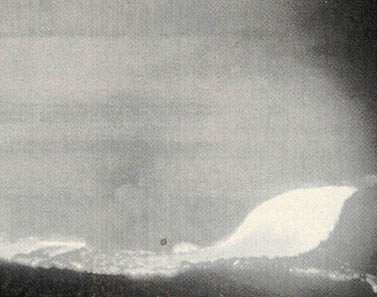최근까지 지구상에서 적어도 12번 이상 분출한 활화산의 수는 5백50개에 달하는 것으로 알려져 있다. 여행객들이 폼페이 화산이나 폭발한 적이 있는 세인트헬레네 산의 분출구로 몰려 다니고 있지만 사실 화산은 매우 위험한 존재다. 화산은 사람과 가축을 죽이며, 우리를 살고 있는 곳에서 몰아내기도 하고 지구의 기후도 변화시킨다. 1815년에 폭발한 인도네시아의 탐보로 화산으로 9천2백명이 희생되었고 콜롬비아의 네바도 델 루이즈 화산의 폭발 때에는 2만3천명이 죽었다.
인류는 오직 하나의 행성에만 살고 있으므로 우리는 화산과 함께 살 수밖에 없고, 가능한 한 화산에 관하여 많이 알아야 한다. 최근 정보에 의하면 화산의 영향을 받지 않는 안전한 곳은 불행히도 이 지구상 어디에도 없다고 한다.
몇몇 활화산들은 가장 추운 곳인 남극 대륙을 둘러싸고 있다. 최근 이들 중 하나인 에레버스의 분화구에 로봇을 보내려는 지질학자들의 시도는 성공하지 못했다. 요즘에는 남극의 얼음 아래에 있는 화산이 발견되고 있다. 이들은 너무 깊이 있어서(2㎞) 오랫동안 어느 누구도 그 아래 뜨거운 어떤 것이 있으리라곤 생각지 못했던 것이다.
작년에는 레이더에 의해서 남극대륙의 서쪽 얼음 아래 기반암으로부터 돌출된 화산 모양의 산이 발견되어 텍사스 대학의 지구물리학자 도널드 블랭컨십과 라몽-도허티 지구 관측소의 로빈벨이 그곳을 탐사하였다. 그들은 숨겨진 산 꼭대기에서 얼음이 떠다니고 있는 약 6㎞ 폭의 구멍을 발견하였다. 이 사실로 볼 때 그 아래의 화산은 여전히 뜨거울 것으로 짐작된다.
만일 남극 얼음 밑의 화산이 폭발한다면 얼음층의 많은 부분이 화염으로 휩싸이겠지만 대기 중으로 분출되지는 않을 것이다. 그러나 너무 많은 얼음층이 녹아서 붕괴된다면 해수면이 상승하여 도쿄나 뉴욕같은 대도시를 침수시키기에도 충분할 것이다. 달리 말해서 온실 효과가 억제된다 하더라도 뉴욕에 사는 필자와 우리 모두는 남극의 화산 때문에 익사할 수 있다.
어쩌면 남극의 화산은 폭발하지 않을지도 모른다. 그러나 안심할 수 없는 것은 최근 들어 활화산의 수가 증가하고 있기 때문이다. 남태평양에 떠 있는 해양조사선 멜빌호의 수중음파탐지기는 이제까지 아무에게도 알려지지 않았던 해저 화산들을 감지하였다. 이 화산들 대부분의 높이는1백m 이상이다.
멜빌호의 과학자 팀은 해양 지구물리학자인 맥도널드, 캘리포니아대학의 지질학자 애트와터, 브라운 대학의 지구물리학자 포리스로 구성되어 있다. 지금까지 그들은 동태평양의 기원으로 알려진 지각의 단층 부근에서 1천1백33개나 되는 해저산과 화산추를 발견하였다. 그 단층은 태평양 판과 나스카 티토닉 판 사이에 있는데 이 두 판은 지구상의 어느 판보다 빠르게 분리되고 있는 중이다.
어떤 산들은 3백마일 정도까지 길게 걸쳐서 분포하고 있으며 적어도 하나 이상의 해저 화산이 지금도 폭발하고 있는 것으로 보인다. 맥도널드 교수의 말과 같이 해저 지면의 약5% 정도만이 정확하게 알려져 있기 때문에 그 수는 더 많을지도 모른다. 로드아일랜드 대학의 해양학자 해럴드 시저슨에 의하면 모든 화산 활동의 90%는 해저에서 일어난다고 한다.
폭발하는 해저 화산은 해수를 데워 기상을 변화시키고 해수의 흐름도 바꾸어 놓을 수 있다. 태평양에서 남아메리카 국가들의 어업을 망치고 아메리카의 남부를 강우로 침수시키는 엘니뇨란 이름으로 알려진 기상과 해류의 변화 원인에 해저화산이 있을 수도 있다.
어떤 과학자들은 해저 화산들이 해수면 아래 1천 피트에 있는 수온약층의 변화에 영향을 줄 정도로 해수를 데우지는 못할 것이라고 주장한다. 만약 1천1백33개의 화산이 한꺼번에 폭발한다면 우리는 이들 과학자들의 주장이 옳기를 바랄 수밖에 없다. 하여간 화산의 위력을 과소평가해서는 안된다.
뜨거운 화산재가 물과 혼합되면 그 영향이 완화될 수 있다고 한 때는 믿어졌으나 리버풀 대학의 지리학자 코켈라와 UC 산타바바라의 캐시 버즈비에 의해 이는 사실이 아닌 것으로 최근 밝혀졌다. 캘리포니아 근처에 있는 한 고대 해저 분화구에 대한 조사에서, 해저 화산에서 생긴 쇄설암(碎屑岩)의 흐름이 상당히 빠르게 움직이면 그 조각과 부석들은 물에 섞이지 않고 서로 엉겨붙는다는 사실이 밝혀진 것이다.
염려되는 것에는 연안 화산도 있다. 이는 매 2만 3천년마다 일어나는, 지구궤도의 요동현상에 의한 태양 광선의 감소로 인하여 닥치는 빙하기와 관계가 있기 때문이다. 뉴욕 대학의 지리학자 램피노와 하와이 대학의 셀프에 의하면 육지에 얼음이 많이 형성될수록 해수면은 낮아진다고한다. 이로 인해서 바다가 연안 화산의 마그마 층에 가하는 압력은 줄어든다. 그러면 화산은 탄산 음료수가 든 병을 흔들었을 때와 같이 그 분출구를 막고 있던 지각을 날려버릴 것이다. 그 다음으로 오는 것은 화산이 발생시킨 공기오염으로 태양 광선이 더 차단되어 지구를 더 식히게 되며, 이로 인하여 빙하기는 더욱 길어질 것이다.
비록 해저에 있는 화산이라 할지라도 우리에게 도움이 될 수 있다. 그것들은 치명적인 가스 재 불들을 지표면에 가져다 주기도 하지만, 금 유황 구리와 같은 광(鑛)퇴적물들도 함께 가져다준다.
언젠가는 우리가 화산을 좀 더 잘 조정하고 이용할 수 있게 될 것이다. 분명한 것은 옛적의 영화인 '천국의 새'에서 벌어진 듯한 장면과 같이 처녀를 화산에 던져넣는 일로 문제를 해결할 수는 없다는 것이다. 영희를 볼 때 나의 어머니가 내 눈을 가리는 바람에 그 장면을 확실히 보지는 못했지만.

Until recently the count was 550 known active volcanoes on Earth, with at least 12 erupting at any moment. Tourists flock to pompeii, or the exploded top of Mount St. Helens, but the fact is that volcanoes are deadly. They kill us and our livestock, force us out of our lands, and alter our weather. In 1815 the Indonesian volcano Tamboro killed 92,000 people, and in 1985, the Colombian Nevado del Ruiz killed 23,000.
Since humans still live only on one planet, we are stuck with volcanoes, and should learn as much as possible about them. Unfortunately, recent information indicates that there's no safe spot on Earth — not from the effects of volcanoes.
A few active volcanoes surround the world's coldest place — Antarctica — and one of them, Mount Erebus, recently foiled the attempts of geologists to send a robot into its crater. Now it's been discovered that there is a volcano under Antarctica's ice, which is so thick(2 kilometers) that for a long time nobody thought there could be anything hot below it
Last year radar showed that under the ice of West Antarctica, a volcano-shaped mountain juts up from the bedrock. This was surveyed by geophysicists Donald Blankenship(from the University of Texas at Austin) and Robin Bell (from Lamont-Doherty Earth Observatory in Palisades, N.Y.). In the ice above the hidden summit they found a 6-kilometer wide hole into which ice is flowing, so it's probable that the volcano beneath it is still hot.
If a volcano below Antarctica's ice erupts, it could burn much of the ice layer but might not explode into the air. Yet if too much of the ice layer melts and collapses, worldwide sea levels would rise enough to inundate many big cities like Tokyo and New York. In other words, the Antarctica volcano can ensure that we (I live in New York) may drown even if the greenhouse effect is controlled!
Perhaps the Antarctica volcano will not erupt, but we can't relax, for recently the count of active volcanoes has gone up. In the South Pacific, the oceanographic research ship Melville's sonar scanning devices have located undersea volcanoes nobody knew were there. Many of these volcanoes are more than 100 meters high.
The Melville's scientific group features marine geophysicist Ken C. Macdonald and geologist Tanya Atwater, of University of California at Santa Barbara, and geophysicist Donald W. Foryth, of Brown University in Rhode Island. So far they have found 1,133 volcanic cones and seamounts near the rift in the Earth's crust known as the East Pacific Rise. This rift is the location of separation between the Pacific and Nazca tectonic plates, which are moving apart faster than any other plates on Earth.
Some of the mountains form a 300-mile long range, and at least one underwater volcano seems to be erupting now. There are probably more, for as Professor Macdonald says, only 5 percent of the sea floor has been accurately mapped. Oceanographer Haraldur Sigurdsson, of the University of Rhode Island, says that 90 percent of all volcanic activity is on the ocean floor.
Erupting underwater volcanoes could alter the climate by warming up water, changing how ocean currents move. In the Pacific this may be the cause of the weather and water current change known as El Nino, which ruins South American fishing and inundates the American South with rain.
Some scientists say underwater volcanoes can't heat up the water enough to disturb the thermocline, the layer of warm water about 1,000 feet below the ocean surface. In case all 1,133 undersea volcanoes erupt at once, let's hope these scientists are correct, but the power of volcanoes should not be underestimated.
It was once believed that water would mix with and moderate the effect of hot ash, but this has recently been disproved by geologists Peter Kokelaar, of the University of Liverpool, United Kingdom, and Cathy Busby, of the University of California at Santa Barbara. By studying what was once an ancient submarine caldera in California, they discovered that if the pyroclastic flow from an undersea volcano is moving fast enough, its glass shards and pumice will not mix with water but be welded together.
Then there are the coastal volcanoes to worry about, for they may be mixed up with ice ages that seem to occur every 23,000 years when fluctuations in Earth's orbit reduce the light reaching us from the sun. According to geologists Michael Rampino of New York University and Stephen Self of the University of Hawaii, when more ice forms on land, sea levels drop. This may reduce the pressure the sea puts on the magma chambers of coastal volcanoes, which would then pop their lids like shaken bottles of carbonated beverages. In turn, the volcano-caused air pollution would cut out more sunlight, cooling the Earth still more. The ice age would increase.
Volcanoes, even undersea, can be useful. They bring to the surface not only deadly gas, ash and fire, but also deposits of minerals like gold, sulfur and copper.
Perhaps some day we will be able to manage and use volcanoes better. What is certain is that we can't cope with volcanoes by throwing virgins into them, as may have happened in the old film "Bird of Paradise." I don't know for sure because my mother held her hand over my eyes.
(c) 1993, Los Angeles Times Syndicate

















